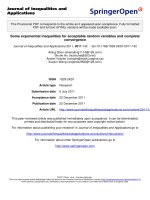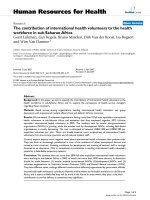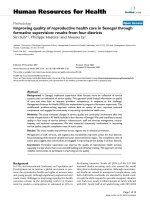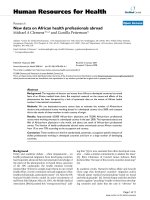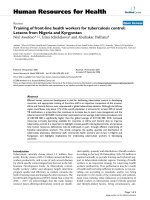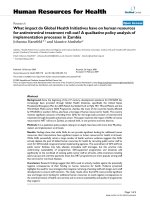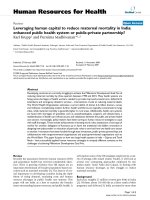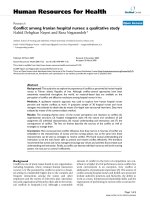báo cáo sinh học:" Rebuilding human resources for health: a case study from Liberia" docx
Bạn đang xem bản rút gọn của tài liệu. Xem và tải ngay bản đầy đủ của tài liệu tại đây (954.59 KB, 10 trang )
Rebuilding human resources for health: a case
study from Liberia
Varpilah et al.
Varpilah et al. Human Resources for Health 2011, 9:11
(12 May 2011)
CASE STUD Y Open Access
Rebuilding human resources for health: a case
study from Liberia
S Tornorlah Varpilah
1*
, Meredith Safer
2
, Erica Frenkel
2
, Duza Baba
2
, Moses Massaquoi
2
and Genevieve Barrow
1
Abstract
Introduction: Following twenty years of economic and social growth, Liberia’s fourteen-year civil war destroyed its
health system, with most of the health workforce leaving the country. Following the inauguration of the Sirleaf
administration in 2006, the Ministry of Health & Social Welfare (MOHSW) has focused on rebuilding, with an
emphasis on increasing the size and capacity of its human resources for health (HRH). Given resource constraints
and the high maternal and neonatal mortality rates, MOHSW concentrated on its largest cadre of health workers:
nurses.
Case description: Based on results from a post-war rapid assessment of health workers, facilities and commun ity
access, MOHSW developed the Emergency Human Resources (HR) Plan for 2007-2011. MOHSW established a
central HR Unit and county-level HR off icers and prioritized nursing cadres in order to quickly increase workforce
numbers, improve equitable distribution of workers and enhance performance. Strategies included increasing and
standardizing salaries to attract workers and prevent outflow to the private sector; mobilizing donor funds to
improve management capacity and fund incentive packages in order to retain staff in hard to reach areas;
reopening training institutions and providing scholarships to increase the pool of available workers.
Discussion and evaluation: MOHSW has increased the total number of clinical health workers from 1396 in 1998
to 4653 in 2010, 3394 of which are nurses and midw ives. From 2006 to 2010, the number of nurses has more than
doubled. Certified midwives and nurse aides also increased by 28% and 31% respectively. In 2010, the percentage
of the clinical workforce made up by nurses and nurse aides increased to 73%. While the nursing cadre numbers
are strong and demonstrate significant improvement since the creation of the Emergency HR Plan, equitable
distribution, retention and performance management continue to be challenges.
Conclusion: This paper illustrates the process, successes, ongoing challenges and current strategies Liberia has
used to increase and improve HRH since 2006, particularly the nursing workforce. The methods used here and
lessons learned might be applied in other similar settings.
Introduction
Following fourteen years of civil war (1989-2003), Liber-
ia’s healthcare system was devastated. Most health pro-
fessionals had fled or died du ring the fighting. In 1988,
prior to the war, there were 3526 persons employed in
the p ublic health sector. By 1998, t his number had
reduced to 1396, with only 89 physicians and 329 nurses
[1]. This paper introduces the historical and political
context that led to the shortage of health workers in
Liberia. It presents the important strides the health sec-
tor has made from emergency to development under
the leadership of President Ellen Johnson Sirleaf (2005),
focusing on the implementation of an emergency
human resources (HR) plan to improve the numbers of
qualified health workers. Using a recent census, a dis-
crete choice experiment (DCE) and training institution
studies, the paper evaluates the success in increasing th e
nursing workforce as well as the ongoing challenges
around redistribution to hard-to-reach areas, training to
improve skills, motivation and task-shifting to fill the
gaps left by continuing physician and physician assistant
shortages.
Health professionals began leaving Liberia to seek better
opportunities when the country’s economic growth began
to slow during the late 1970s. In 1979, dissatisfaction over
* Correspondence:
1
Ministry of Health and Social Welfare, Monrovia, Liberia
Full list of author information is available at the end of the article
Varpilah et al. Human Resources for Health 2011, 9:11
/>© 2011 Varpilah et al; licensee BioMed Central Ltd. This is an Open Access article distributed under the terms of the Creative Commons
Attribution License (http://creative commons.org/licenses/by/2.0), which permits unrestricted use, distribution, and reproduction in
any medium, provided the original work is prop erly cited.
governmental plans to raise the price of rice led to protests
in Monrovia. Seventy people were killed when military
troops fired on protesters. Rioting ensued throughout
Liberia and culminated with a coup by Samuel Doe in
1980. At this time and throughout the 1980s, as instability
increased and the c urrency value decreased, high-level
professionals continued to leave the country, creating
large vacancies in the health system at all levels. This pro-
blem was only compounded when concessions (businesses
operated under contract with business exclusivity within a
defined geographical area) also pulled out of Liberia, tak-
ing with them their trained health workers.
In 1989 National Patriot Front forces, led by Charles
Taylor, entered Liberia from Côte d’Ivoire and unseated
the Doe government. By 1990 most medical specialists
had left L iberia leaving only general practitioners. From
1989 to 2003, civil war resulted in a severely fragmented
and incapacitated health syst em. As conces sionaires and
high-level workers left, non-governmental organization
(NGO) emergency aid organizations began to arrive.
The first to enter was Médecins Sans Frontières (MSF)
in 1989. This began an NGO-centric health care system
in which health facilities were dependent on external aid
to function. By 2003, Liberia had 420 facilities (12 public
hospitals, 32 public health centers, 189 public clinics, 10
private hospitals, 10 privat e health centers, 167 private
clinics), 45% of which were being managed by NGOs
and faith-based organizations (FBOs) [1]. Large numbers
of displaced people moved into Monrovia, doubling the
population and quickly outgrowing the city’scapacityto
provide health services with limited health workers and
destroyed infrastructure. Community cohesiveness dis-
solved as members were displaced to Monrovia, neigh-
bouring countries or new settlements along main roads.
Training institutions c losed during fighting and re-
opened during calm periods. By 2002, five of seven pre-
war schools were operational: A.M. Dogliotti College of
Medicine (physicians) was operational, but due to the
collapse of the John F Kennedy teaching program it
graduated only seventeen students between 1999 and
2002; Tubman National Institute of Medical Science
(physician assistants, nurses, midwives, environmental
health practitioners) graduated a total of 464 students
between 1999 and 2002; from 2000 to 2002 Cuttington
University College School of Nursing graduated 95
nurses and Mother Patern School of Health Science
graduated 221 associate degree nurses. Phebe School of
Nursing and Midwifery w as operational but did not
graduate students until 2003 [2]. The start and stop of
education, limited educational resources and a lack of
qualified professors in the country meant that few per-
sons were able to go to school, fewer were able to com-
plete it and none were able to match the quality of
education received prior to the war. An Assessment of
Health Training Institutions conducted by United States
Agency for International Developme nt (USAID) and the
Ministry of Health and Socia l Welfare (MOHSW) in
2007 found that only Phebe School of Nursing & Mid-
wifery and Mother Patern School of Health Sciences
had the appropriate resources (textbooks, teaching
laboratories, demonstration models, etc.) to provide a
conducive learning experience [3].
For health workers that did remain in Liberia during
the war, salary payments stopped and food became pay-
ment for work. In late 2003, Liberia signed the Compre-
hensive Peace Agreement in Ghana, ending the war and
ushering in a transitional government supported by Uni-
ted Nations peacekeeping troops. In 2005, elections were
held, and in 2006, Africa’s first female president, Ellen
Johnson Sirleaf, was inaugurated. By this time, there
were less than 20 physicians, as compared to the 237
that had worked in the sector pre-war [4]. Nurses made
up the majority of the remaining workforce. By 2006,
there were 668 nurses (registered nurses, and licensed
practical nurses) and 297 certified midwives. Together
with an additional 1091 nurse aides, they p rovided the
majority of primary care [2]. At the time that this paper
is written, Liberia’ s health sector continues to face a
severe shortage of qualified health workers across all
cadres except nurses.
Case description: rebuilding health human
resources
Establishing strong, coordinated leadership
By 2005, two years after the peace agreements were
signed, the health sector was in disarray and dependent
on more than $80 million of international humanitarian
aid. Without oversight and coordination, this aid was
distributed according to disparate donor priorities that
did not necessarily match priority needs of the health
sector [5]. As a result, the health system was barely
functioning, with only an estimated 40% of Liberians
able to access basic health services [6]. Following the
inauguration of the Sirleaf administration in 2006,
MOHSW initiated three reform actions in line with the
national development priorities to strengthen healthcare
delivery and outcomes in Liberia: (1) Build an experi-
enced and visionary leadership team, divorced from
political agendas; (2) Strengthen partnership and coordi-
nation to mobilize resources, align programs and har-
monize all sector efforts; and (3) Develop and
implement an evidence-based National Health Policy &
Plan (NHP&P) to unify vision and direction for Liberia’s
post conflict health sector reform process.
The first reform priority was to build a strong leader-
ship team with a shared vision for health reform. Minis-
try officials were appointed to their positions based on
experience, academic qualifications, competence and
Varpilah et al. Human Resources for Health 2011, 9:11
/>Page 2 of 9
good human rights records rather than political affilia-
tions. The first actio n of the new MOHSW, in line with
the second reform priority, was to coordinate and lead
the many stakeholders in the sector. This resulted in the
creation of two coordinating mechanisms: (1) the Health
Sector Coordination Co mmittee (HSCC), comprised o f
senior representatives of donors and partner NGOs who
mobilize resources, a dvise the Minister and help guide
the reform process and (2) the Health Coordination
Committee (HCC), comprised of NGO/FBO service pro-
viders and MOHSW department officials to provide
technical guidance on healthcare delivery.
With very limited information available, MOHSW
developed the 2007-2011 NHP&P and focused on build-
ing management capacity at the central and county
levels to enhance a coordinated approach. Donor fund-
ing was leveraged to support key management positions,
including the establishment of the first MOHSW HR
Unit. In December 2007, a HR Director was hired to
coordinate all HR activities, incl uding scholarships and
incentives. Funded by the Civil Service Authority (CSA),
the HR Unit is responsible for the development and
oversight of HR policies and plans for the health and
social welfare workforce, as well as to collect and disse-
minate HR data. Keeping with the NHP&P s trategy of
decent ralization, funding was used to hire and train HR
Officers to wo rk as part of ea ch County Health and
Social Welfare Team (CHSWT) managing county
worker recruitment, deployment and performance. Prior
to the establishment of HR officers in each CHSWT,
there wasn’ tanyoneatthecountyleveltofeeddata
back to a central repository, enabling evidence-based
HRH planning and management.
Identifying Gaps
A critical next step to unify and drive health system
reform was to understand the existing health needs and
what gaps existed. To do this, MOHSW commissioned
two integrated studies in 2006: (1) A rapid assessment,
which sent enumerators to everycountytoidentifythe
number, location and cadre of health workers; the number
of functional health facilities; and the number of NGOs
and FBOs; and (2) Community surveys to determine
health priorities and recommendations for each region.
Findings highlighted the long-term adverse impacts of
prolonged war on the health system. Curable diseases
such as malaria, diarrhoea and acute respiratory infec-
tion emerged as the leading causes of morbidity and
mortality. Maternal mort ality, depending on the source,
was estimated between 580 and 760 per 100 000 live
births, while infant mortality was 157/1000 live births,
and under-five mortal ity was slightly higher at 235/1000
live births [7]. Overall life expectancy at birth was 41
years [8]. Facility infrastructure was ruined due to
looting or community displacement. Only 354 of the
550 pre-war facilities remained functional, of which 80%
were operated by NGO or FBOs [9]. Without govern-
ment oversight, NGOs and FBOs provided largely vary-
ing health services according to their own priorities. At
the facility level, equipment had been destroyed or sto-
len; there was no electricity, little access to clean water
and no communication network. Roads had been
neglected, making many areas difficult to reach or, in
some places, inaccessible during the rai ny season. With-
out oversight, coordination and finances, most facilities
were without needed drug and supply stocks.
Moreover, as most high-level professionals had left by
the end of the war, a lack of management capacity at all
levels and a shortage of qualified healthcare workers
exacerbated each of these challenges. The rapid assess-
ment determined the total clinical workforce (private,
NGO and government) to be 3107 persons. Thirty-five
percent of these were nurse aides and 30% were in the
capital county of Montserrado due to accelerated urba-
nization. In 2006, with an estimated population of 3.2
million, Liberia had approximately 0.97 health workers
per 1000 population, or 0.51 health workers per 1000
population if nurse aides were excluded [9]. There were
a total of 965 nurses in Liberia: 402 Registered Nurses
(RN), 297 Certified Midwives (CM ), 214 Licensed Prac-
tical Nurses (LPN), 40 Nurse Anaesthetists, and 12 com-
bined RN/CMs [9]. (An LPN received two rather than 3
years of formal training. The Zorzor LPN training pro-
gram closed in 1991 due to the war and was not
restarted in order to focus resources on training RNs.
When referring to a nurse post-2006, it will be synon-
ymous to RN.) Production of health workers was a com-
plex challenge. Each of the remaining training
institutions had significant operating challenges includ-
ing ruined infrastructure, limited funding, lack of faculty
and training capacity, overcrowded classes, outdated
curricula, insufficient resources and no regulation [3].
Government salaries, set by the CSA, were low and
did not regard grade, position or progression. Further-
more, government salary payment was consistently
delayed and no incentives were paid to health workers
deployed in hard to reach, underserved locations. These
salary pr oblems plus a lack of national benefits resulted
in the migration of skilled staff to NGO facilities. With-
out HR information systems, one of the largest chal-
lenges became reconciling the payroll to identify and
remove the high number of ghost workers (persons col-
lecting pay but not working in the system or salaries
paid to non-existent people).
Moving forward: emergency human resources planning
Across Africa, countries that have experienced shortages
of health workers like Liberia have adopted different
Varpilah et al. Human Resources for Health 2011, 9:11
/>Page 3 of 9
strategies to addr ess their health worker shortages.
When Liberia’s Emergency HR Plan was developed in
2007, several strategies from other Afric an countries
were considered. Similar to Ethiopia, Liberia considered
creating a new cadre of health workers, called health
care assistants, which would take a shorter time to train
than nurses. This plan was modified to be a non-salaried
program for community health volunteers, who cur-
rently provide education and treatment for diarrhoea-
related illness in communities. This program will be
scaled-up as more preventative and primary care train-
ing modules are developed.
Liberia borrowed a few p rinciples from Kenyan and
Malawian models, such as utilization of donor funds in
Kenya to fill priority posts in the health sector, and the
commitment of service required from beneficiaries of
scholarships, stipends and housing in Malawi. Liberia’s
Emergency HR Plan 2007-2011 had four objectives: (1)
Enhance a coordinated approach to HR planning; (2)
Increase the number of trained health workers and their
equitable distribution; (3) Enhance health worker perfor-
mance, productivity and retention; and (4) Ensure gen-
der equity in employment especially in management
positions. Although targets were set for the recruitment
and production of all cadres of health workers, nurses
and midwives were prioritized as a means of addressing
the high maternal and infant mortality rates in Liberia.
To increase the number of trained health workers,
MOHS W took several measures to accelerate the devel-
opment and recruitment of nurses and midwives. One
measure was the standardization of salaries, which has
been credited, by MOHSW Director of th e Nursing and
Midwifery Division, as the most important factor for the
increase in the numbers of nurses hired by the govern-
ment. This involved a review and standardi zation of sal-
aries and allowances across the board in the h ealth
sector, in partnership with the CSA and Ministry of
Finance, which effectively increased the pay of govern-
ment health workers and ensured that health worker
salaries were uniform within the Ministry as well as
within NGOs. This helped stem the outflow of health
workers from t he public sector and also brought back
health workers that might have left the health sector as
a result of low salaries. Monthly salaries for nurses
increased from 900 Liberian Dollars (US$ 13) to 7590
Liberian Dollars (US$ 108) in 2009 [Personal Communi-
cation: Baba, D. with MOHSW Director of Payroll, July
12, 2010].
Even with better salaries for health workers,
MOHSW’s ability to hire additional health workers w as
constrained by the dual challenge of limited resources
and an e mployment ban in the public sector. The
employment ban was one of the conditions Liberia
agreed to in order to benefit from debt relief under the
joint International Monetary Fund (IMF)- World Bank
(WB) Bank Heavily Indebted Poor Country Initiative
(HIPC). It was revised in 2007 to allow the government
a moderate increase in minimum wage but continues to
keep salaries low and impacts the ability of the govern-
ment to hire new civil servants. The MOHSW HR Unit
circumvented this employment ban by utilizing donor
funds to boost its work force. This involved identifying
priority positions together with donors and recruiting
‘volunteer’ health workers who were given an incentive
payment in lieu of being placed on the government pay-
roll. In 2009 the government of Liberia (GoL) allocated
US$ 10,187,743 to the health sector. The personnel
costs alone were US$ 6,962,709, amounting to 70% of
MOHSW allocation from the government. With total
MOHSW expenditures in the health sector a mounting
to US$ 23,524,55 4 in 2009, the MOHSW would have
had a US$13.5 million gap were it not able to raise close
to US$ 20 million from donor s (Pool Fund, Global
Fund, Earmarked Donor Funds, NGOs) [10]. As of June
2010, a total of 1748 nurses were receiving incentive
payments from MOHSW and its partners. Additionally,
all 11 senior ministry officials, 56 doctors and 23 phar-
macists received incentives paid through donor funding
[11]. These measures to increase the number of health
workers working for the government without increasing
its wage bill are considered to be stopgap measure s. It is
planned that these health workers will be absorbed on
the government payroll as the economy continues to
grow and allocations to the health sector increase.
Additional measures were taken by MOHSW to
increase t he pool of health workers that could be
recruited in the future and improve distribution. Histori-
cally, medical education was free. However, during the
war fees were introduced. In 2006, the government re-
opened three rural training institutions and reinstituted
free medical educat ion to increase enrolment. Through
the National In-Service Education Strategy, curricula for
mid-level health workers were revised and standards of
care introduced to improve pre-service training. From
2007 to 2011, GoL spent over US$ 335,000 to support
student tuition at Liberia’s government and private med-
ical institutions. In-country scholarships have gone to
students to become nurses, midwives, lab technicians,
nurse anaesthetists and social workers. To date, 28 stu-
dents have received international scholarships, funded
by USAID, for program management or master degrees
in public health. Sixteen of these students have com-
pleted their programs and returned to promoted health
worker roles in Liberia. The remaining 12 are finishing
their programs.
To improve distribution to hard to reach areas, the
MOHSW HR Unit developed a regional incentive pack-
age to top up government salaries for persons working
Varpilah et al. Human Resources for Health 2011, 9:11
/>Page 4 of 9
in hard-to-reach areas and re-introduced stipends with a
bonding system for students (particularly student
nurses). The bonding system requires health workers
benefiting from stipends to serve the government in a
hard to reach area for a period of time, usually corre-
sponding to the length of their studies. Their certificate
of graduation is given to them only after they complete
the agreed upon service time in a hard to reach area.
The first of these students should be graduating soon.
Discussion and evaluation
Increased numbers of health workers and their equitable
distribution
In 2009, foll owing the first f ull accreditation of facility
provision of Liberia’s Basic Package of Health Services
(BPHS), staffing information was used by the HR Unit
to identify facility gaps and deploy recent graduates
from Phebe Nursing School and TNIMA. Twenty-three
clinics without a required Officer In Charge (OIC) were
prioritized to r eceive a PA or RN. Additional PAs and
RNs, as well as CMs and Environmental Technicians
were deployed to facilities with shortages. Table 1 shows
the reduction in national staffing deficits based on the
BPHS minimum staffing requirements from 2009 to
2010. Most notable is that the RN gap closed after these
deployments, when all 46 identified positions were filled.
The Accreditation gave MOHSW its first look at
national staffing since the development of the BPHS,
however these numbers were subjectively reported by
the facility OIC and not verified through employee
records or visual confirmation. To impr ove information
and begin strengthening HR st rategies and planning, the
MOHSW HR Unit completed the first national HR cen-
sus in 2009. With support from the World Bank, the
census confirmed the presence and qualifications of all
accessible public a nd private facility staff, finding 8768
health workers, 4653 of which were clinicians. In 2010,
with a population of 3.518,437, this equals 1.3 clinical
health workers per 1000 population, far below the
World Health Organization (WHO) recom mendation of
2.2 health workers per 1000 persons in order to assure
80% of coverage of deliveries supervised by a skilled
birth attendant.
While the overall ratio of clinicians to population
remains low, w. Table 2 compares the number of work-
ers per cadre in 2006 and 2009 against targets set in the
Emergency HR Plan. In 2009, the percentage of the clin-
ical workforce m ade up by nurses and nurse aides
increased to 73%. During this time, the number of
nurses more than doubled, t he majority being RNs as
the LPN program was discontinued. However, while the
number of CMs increased by 28%, this fell far short of
the Emergency Plan targets. Likewise, PAs, the interim
strategy to offset the severe shortage of physicians, also
fell dramatically short of the Emergency Plan targets.
The overall sub-optimal production of CMs and PAs
versus the significant increases in RNs suggests a lack of
coordination with pre-service training institut ions as
well as in consistencies in salaries and advancement
opportunities. For example, an RN is paid more than a
CMandismorelikelytobeplacedastheOICofa
facility, thus receiving an increased monthly salary, US$
75 greater than a CM.
As of 2009, the census showed that the numbers of
physicians, RNs and nurse aides surpassed the BPHS
minimum requirements. Recognizing that t he require-
ments were four y ears old and set with limited sector
information, the MOHSW HR Unit, with Clinton
Health Access Initiative (CHAI) support, conducted a
workforce optimization study to review minimum staff-
ing requirements and calculate optimal workforce needs.
The workforce optimization analysis utilized a demand-
based model, which calculated the optimal number of
health workers needed by cadre at health facilities based
on service utili zatio n rates and workload, obtained from
the Health Management Information System (HMIS)
database and worker interviews. Findings showed that
while BPHS staffing requirements correctly identified
the need for nurse aides and dispensers, the need for
CMs was overestimated, and the need for physicians,
PAs and RNs significantly underestimated. To inform
priority setting, the study also identified the relative
need for each of these cadres. Figure 1 shows the
national optimal workforce relative needs by cadre.
While the nursing cadre numbers are strong and
demonstrate significant improvement since the crea-
tion of the Emergency HR Plan, equitable distribution
continues to be a challenge. The workforce optimiza-
tion highlighted the concentration of nurses and health
workers at hospitals and urban areas, to the disadvan-
tage of health centers, clinics and rural areas. Table 3
shows the relative need of each health worker cadre by
facility type. Nurse aides are the onl y cadre in which
there is a surplus at each f acility type. This surplus is
minimal at the clinic level and increases significantly at
Table 1 Change in national health workforce 2009-2010
2009
Deficit
2010
Deficit
Deficit
reduction
Physician Assistant 46 31 33%
Registered Nurse 46 0 100%
Certified Midwife 263 207 21%
Laboratory Technician 32 34 -6%
Operating Theater
Technician
90 80 11%
Anesthetist 77 21 73%
Sources: 2009 [16] and 2010 [17]
Varpilah et al. Human Resources for Health 2011, 9:11
/>Page 5 of 9
the health center and hospital levels-most likely due to
the informal task shifting-that happens when advanced
clinical sta ff, such as PAs, are unavailable to do the
tasks required at these facilities. Alternatively, CMs
and RNs are concent rated at hospitals, leavi ng clinics
and, in the case of RNs, health centers, severely
understaffed.
Currently the MOHSW HR Unit, with WB and
CHAI support, is conducting a training pipeline and
costing analysis. These findings will identify costed
intervention areas for Liberia’s training institutions to
meet the optimal workforce needs. As MOHSW works
to increase the number of physicians a nd PAs, it is
using findings from the workforce optimization study
to formalize task-shifting opportunities. Once task-
shifting plans are finalized to include appropriate
remuneration, opportunities to redistribute nurses and
midwives from areas with excess capacity to facilities/
counties suffering severe shortages will be identified.
This is particularly important considering that clinics
are the primary point of care for the majority of Liber-
ians, as most health centers and all hospitals are
located in county capital s. If the number of surplus
nurses found at hospitals were redistributed, it would
meet the optimal need of all the clinics in Liberia and
almost half of all health centers [12].
Table 2 National stock of health workers by cadre as compared to Emergency Plan targets (2006 and 2009)
Cadre 2006 Rapid
Assessment
2009 Emergency
Plan Target
2009
Census
2009 Emergency Plan
Shortfall
2010 Emergency
Plan Target
2010 Emergency Plan
Shortfall*
Physician 168 210 90 120 215 125
Physician
Assistant
273 496 286 210 507 221
Nurse (RN/LPN) 668 567 1393 -826 595 -798
Nurse Aide 1091 n/a 1589 n/a n/a n/a
Certified
Midwife
297 659 412 247 708 296
Dentist 13 n/a 23 n/a n/a n/a
Laboratory
Technician
149 159 137 22 163 26
Laboratory
Assistant
156 378 239 139 387 148
X-Ray
Technician
25 60 22 38 62 40
Pharmacist 31 73 46 27 74 28
* Compared with the most recent data available: 2009 HR Census
Sources: 2006 [5] and 2009 [13]
Figure 1 National optimal workforce needs by cadre (2010). Source: [18].
Varpilah et al. Human Resources for Health 2011, 9:11
/>Page 6 of 9
Enhancing health worker performance, productivity and
retention
Retention
In addition to being concentrated at hospitals, nurses
are concentrated in urban areas, particularly the capital
county of Montserrado. According to the 2008 National
Census, approximately one-third of Liberia’s population
lives in Montserrado. Overall, 33% of health workers are
in Montserrado, and of these, 6.8% were born in the
county [13].
In order to comprehensively address retention in ha rd
to reach areas, the MOHSW HR Unit and WB con-
ducted a DCE for nurses in June 2010. The DCE quanti-
tatively estimated how health workers value different
aspects of their job in order to identify cost-effective
policy options. Researchers spoke with a representative
sample of nurses from a number of counties (notably
three southern counties were excluded b ecause they
were too difficult to manage logistically) and questioned
them on how they valued six aspects of their job: loca -
tion, total pay, conditions of equipment, availability o f
transportation, availability of housing, and workload.
The study recommended three policy interventions to
increase retention of nurses in rural areas. The first is to
recruit students from rural areas and expose all students
to rural working conditions during their training.
According to the DCE and corroborated by international
evidence as described in the global policy recommenda-
tions “Increasing access to health workers in remote and
rural areas through improved retention”[14], exposure
to rural areas leads to a significantly higher willingness
to work in those areas. Second, the most cost-effective
option is to give US$50 bonuses to nurses working in
rural areas. This would increase the percentage of
nurses willing to work in the rural areas from 34%
(baseline) to 49%. This is a similar increase that would
occur if MOHSW improved equipment o r provided
housing, but at a much lower cost. Finally, the third
intervention is to provide nurses in rural areas with
transportation. Ideally, the DCE recommended combin-
ing this optio n with a US$50 bo nus to substantially
increase willingness to work in rural areas.
Productivity
Liberia has been using task shifting to increase service
availability with limited HR since 1958 when the school
for PAs was created to address the shortage of
physicians in the country at the t ime. In recent years,
however, the severe shortage of health workers at all
levels has heightened the urgency of shifting tasks from
highly trained providers to available staff with less train-
ing. As a result, throughout the war and in the years
immediately following it, widespread, informal task shift-
ing took place.
MOHSW has begun formalizing task shifting to
ensure quality and safety. Focusing on the largest cadre
of health workers, four areas are being task-shifted to
nurses, midwives and nurse aides:
1. In addition to physicians and PAs, RNs and CMs
will be trained to do emergency obstetric and neona-
tal care (EmONC) including caesarean sections at
hospitals and health centers;
2. Nurse aides will be trained to be vaccinators
across all facility types;
3. With only one psychiatrist in t he country, nurses
and nurse aides will be trained to provide mental
health services.
MOHSW has created a new c adre of health worker,
Nurse Anaesthetists, who will administer anaesthesia for
minor operations at heal th centers and hospitals [Perso-
nal communication Frenk el, E. with Jessie Ebba-Duncan,
MOHSW Assistant Minister for Preventative Services,
July 11, 2010]. To do this, MOHSW is targeting both
pre- and in-service training opp ortunities. Cu rrently,
MOHSW is working with training institutions to
broaden the trai ning of current students to include
mental health and EmONC. For existing nurses,
MOHSW offers training courses for nurses and nurse
aides who are prepared to take on additional tasks.
Finally, hospitals can apply for permission to train nurse
aides in spe cific nursing services ba sed on the needs of
the facility. After receiving this training, the newly
trained nurses will be permitted to perform those tasks
only at the facility that trained them.
Performance
To improve performance, MOHSW has focused, to date,
on in-service training and establishing strong leadership
and oversight. With limited resources to invest in pre-
service training and the need to improve the quality of
services immediately, MOHSW created in-service train-
ing modules for the BPHS which every facility clinical
Table 3 Relative need of cadres per facility type
Physician Physician Assistant Nurse Nurse Aide Midwife Dispenser
Clinic n/a 500% 106% -1% 151% 44%
Health Center n/a 30% 56% -36% -15% 21%
Hospital 107% 29% -52% -82% -58% -53%
Source: [18]
Varpilah et al. Human Resources for Health 2011, 9:11
/>Page 7 of 9
worker is required to complete. To ensure dedicated HR
leadership, the HR Unit was established and manage-
ment performance improved t hrough donor-funded
technical assistance and internatio nal trainin g opportu-
nities. Two clinical supervision programs were imple-
mented to ensure facility mentoring and monitoring.
Each CHSWT is staffed with a Clinical Supervisor
whose job it is to provide monthly supervision and assis-
tance to each facility in the county. Additionally, central
MOHSW teams are deployed to provide mentoring to
the facilities once a year. Logistical challenges such as
the constant disrepair of vehic les mean supervision does
not currently happen as often as it should.
It has been increasingly recognized that implementing
strong HR policy and management has to be at the core
of any sustainable solution to health system perfor-
mance [15]. Utilizing evidence from the studies
described, the MOHSW HR Unit is currently finalizing
the first HR Policy & Plan, which is expected to improve
performance at all levels by clearly setting and commu-
nicating the standards. The BPHS Accreditation has
helped to communicate service standards and measure
progress against t hem. In doing so, it has ensured that
each health worker has a cl ear understanding of what
services should be provided at the facility. Setting clear
expectations and e valuating performance at the indivi-
dual worker level has been more diff icult. Job descrip-
tions are now standardized for each cadre, however they
have not been broadly communicated to staff. For
nurses, many of the tasks they a re picking up through
informal task shifting are not recognized in these
descriptions. While a performance evaluation process
was developed and is required, its practice is not widely
implemented. Without increased compensation for addi-
tional tasks or years of service and no opportunities for
advancement, motivation for nurses to improve perfor-
mance is an ongoing challenge.
Conclusion
Since the creation of the Emergency HR Plan in 2007,
MOHSW has developed a strong management frame-
work, improved HR coordination and significantly
increased the number of nurses and midwives. Key
interventions are responsible for these successes. First,
strategically mobilizing donor funding and support to
improve numbers and performance through training
opportunities, salary incentives and techn ical assistance
is credited as creating greater numbers of qualified
nurses. Second, standardizing NGO salaries to match
MOHSW pay amounts has stopped a large portion of
outflow from the public to the private sector. Third,
reopening training institutions and focusing on increas-
ing skills through in-service training and mentoring has
greatly reduced the number of nursing gaps at the
facility level and increased nurses’ ability to manage
facility services that physicians and Pas would otherwise
provide.
During this time, MOHSW has found that while
strong leadership and uniform objectives ar e important,
it is also necessary to admit weaknesses and ask for help
when needed. Man y of the standard international strate-
gies to improve human resources such as continuing
education, supervision and incentive payment do not
consider Liberia’s specific challenges. With the help of
impl ementing partners and donors , MOHSW has found
it useful to reject the international blueprint and develop
strategies targeted to Liberia’s unique challenges. Many
of these challenges remain, particularly a round regula-
tion, payroll management, equitable distribution, reten-
tion of health workers in hard to reach areas and
improving performance to impact the quality of services
provided. In the last year, MOHSW has taken an evi-
dence-based approach to understanding these challenges
in order to define strategies for the first national HR
policy and plan. Further work is needed to ensure popu-
lation and utilization-based staffing norms, appropriate
standardized salaries, improved training quality and pro-
duction, opportunities for career advancement and a
robust monitoring and evaluation system, critical to suc-
cessful coordination. While the availability and reliability
of MOHSW information systems has greatly improved,
significant challenges remain for gathering and mana-
ging HR information. Following much work to develop
CHT management capacity, MOHSW has recently
begun installation of an HR software system that will
enable continuous management of health worker
employment, payroll and performance-bas ed opportu-
nities. In 2011 MOHSW plans to merge the HR Divi-
sion and the Personnel Department, historically
independent areas, to continue to streamline systems for
improved coordination.
New i nitiatives to improve staff performance and
motivation are underway, most notably the first c ounty
decentralization project and performance based finan-
cing. In 2010, MOHSW awarded the Bomi CHSWT US
$ 2.2 mill ion to fully manage and improve county
health. A large part of this project is the work to deter-
mine the right package of financial and non-financial
incentives in order to develop and maintain a qualified
and motivated workforce. Health workers continue to
be drawn t o Monrovia for its h ousing, stronger school
systems and easier work conditions. Currently, the
CHSWT is exploring incentives such as weekend and
overtime pay, staff housing and increased salaries to
develop national strategies for retaining and improving
staff in counties outside of Montserrado. Additionally,
MOHSW has started using performance-based financing
from its Pool Fund, and through partnership with the
Varpilah et al. Human Resources for Health 2011, 9:11
/>Page 8 of 9
USAID-funded Rebuilding Basic Heal th Services (RBHS)
project. Facilities meeting a defined set of indicators,
including their BPHS Accreditation score, receive per-
formance-based funding to use how t hey best see fit.
This may be given out to staff or used to procure neces-
sary items for the facility, etc. This process will be
reviewed in 2011 to determine its impact. New available
information, including the recently established catch-
ment population database and community to facility dis-
tances will enable MOHSW to develop facility
distribution and staffing norms b ased on population
density and utilization. Finally, MOHSW is beginning to
develop a quality management cycle. Rather than simply
measuring the provision of BPHS services through the
Accreditation, the quality of health workers’ provision of
services will be assessed.
Abbreviations
BPHS: Basic Package of Health Services; CHAI: Clinton Health Access Initiative;
CHAL: Christian Health Association of Liberia; CHO: County Health Officer;
CHSWT: County Health and Social Welfare Team; CM: Certified Midwife; CSA:
Civil Service Agency; DCE: Discrete Choice Experiment; EmONC: Emergency
Obstetric and Neonatal Care; FBO: Faith-Based Organization; GDP: Gross
Domestic Product; GOL: Government of Liberia; HCC: Health Coordination
Committee; HEW: Health Extension Worker; HMIS: Health Management
Information System; HR: Human Resources; HRH: Human Resources for
Health; HSCC: Health Sector Coordination Committee; IMF: International
Monetary Fund; LD: Liberian Dollar; LPN: Licensed Practical Nurse; MD:
Medical Doctor; MOH: Ministry of Health; MOHSW: Ministry of Health &
Social Welfare; MSF: Médecins Sans Frontières; NDS: National Drug Service;
NGO: Non-Governmental Organization; NHP: National Health Plan; NHP&P:
National Health Policy & Plan; OIC: Officer In Charge; PA: Physician Assistant;
RBHS: Rebuilding Basic Health Services; RHP: Rapid Staffing Hire Plan; RN:
Registered Nurse; TNIMA: Tubman National Institute of Medical Arts; USAID:
United States Agency for International Development; WB: World Bank; WHO:
World Health Organization.
Acknowledgements
Most official records were destroyed or lost during the war. As a result,
where documentation could not be found, information for this paper was
taken from interviews with key members of the health sector. The authors
would like to thank the following people for their time and contribution:
Lenora Dunbar, Jessie Ebba-Duncan, Henry Salifu and Musu Washington.
Author details
1
Ministry of Health and Social Welfare, Monrovia, Liberia.
2
Clinton Health
Access Initiative, Monrovia, Liberia.
Authors’ contributions
The work presented here was carried out in collaboration between all
authors. All authors read and approved the final manuscript.
Competing interests
The authors declare that they have no competing interests.
Received: 26 October 2010 Accepted: 12 May 2011
Published: 12 May 2011
References
1. Government of Liberia: Ministry of Health & Social Welfare and World
Health Organization, Liberia Health Situation Analysis, Final Report. (Geneva
WHO, 2002)
2. D Walsh, A Narrative Analysis of the Stories of Nurses Working in Liberia
Pre, During and Post Civil War. PhD dissertation. (Tolland, Connecticut:
University of Connecticut, School of Nursing, 2010)
3. USAID, Liberian Ministry of Health and Social Welfare, Academy for
Educational Development, An Assessment of health Training Institutions in
Liberia. (Washington, DC: USAID, 2007)
4. E Sondorp, C Msuya, Interagency Health Evaluation: Liberia. (Interagency
Health and Nutrition Evaluations in Humanitarian Crises Initiative Working
Group/UNHCR, Geneva, 2005)
5. Government of Liberia: Ministry of Health & Social Welfare, Rapid Assessment
of the Health Situation in Liberia. (Monrovia: USAID, 2006)
6. WHO Statistical Information Service. />pdf (2011). Accessed 21 March
7. Ministry of Health & Social Welfare, Road Map for Accelerating the Reduction
of Maternal and Newborn Morbidity and Mortality in Liberia. (World Health
Organization. Monrovia, 2007)
8. UNICEF, State of the World’s Children Report 2005. (New York: Childhood
Under Threat, 2004)
9. Government of Liberia: Ministry of Health & Social Welfare, Emergency
Human Resources for Health Plan 2007-2011. (Ministry of Health & Social
Welfare: Monrovia, 2007)
10. Government of Liberia, OFM Extract for MOHSW Annual Report. (Monrovia:
Ministry of Health & Social Welfare, 2010)
11. Government of Liberia, OFM Payroll Database. (Monrovia: Ministry of Health
& Social Welfare, 2010)
12. MOHSW/CHAI, Workforce Optimization Model: Optimal Health Worker
Allocation for Healthcare Facilities across the Republic of Liberia. (Monrovia:
Ministry of Health & Social Welfare, 2010)
13. MOHSW/World Bank, 2010 Health Human Resources Census Results.
(Monrovia: Ministry of Health & Social Welfare, 2010)
14. C Dolea, L Stormont, D Shaw, P Zurn, JM Braichet, Increasing access to
health workers in remote and rural areas through improved retention. (World
Health Organization Geneva, 2009)
15. J Buchan, What difference does ("good”) HRM make? Human Resources for
Health. 2, 6 (2004). doi:10.1186/1478-4491-2-6
16. Government of Liberia: Ministry of Health & Social Welfare, 2009 BPHS
Accreditation: Final Results Report. (Monrovia: Ministry of Health & Social
Welfare, 2009)
17. Government of Liberia: Ministry of Health & Social Welfare, 2010 BPHS
Accreditation: Final Results Report. (Monrovia: Ministry of Health & Social
Welfare, 2010)
18. M Vujicic, M Alfano, M Ryan, C Sanford Wesse, J Brown-Annan, Policy
Options to Retain Nurses in Rural Liberia: Evidence From a Discreet Choice
Experiment. (Monrovia: MOHSW/World Bank, 2010)
doi:10.1186/1478-4491-9-11
Cite this article as: Varpilah et al.: Rebuilding human resources for
health: a case study from Liberia. Human Resources for Health 2011 9:11.
Submit your next manuscript to BioMed Central
and take full advantage of:
• Convenient online submission
• Thorough peer review
• No space constraints or color figure charges
• Immediate publication on acceptance
• Inclusion in PubMed, CAS, Scopus and Google Scholar
• Research which is freely available for redistribution
Submit your manuscript at
www.biomedcentral.com/submit
Varpilah et al. Human Resources for Health 2011, 9:11
/>Page 9 of 9

